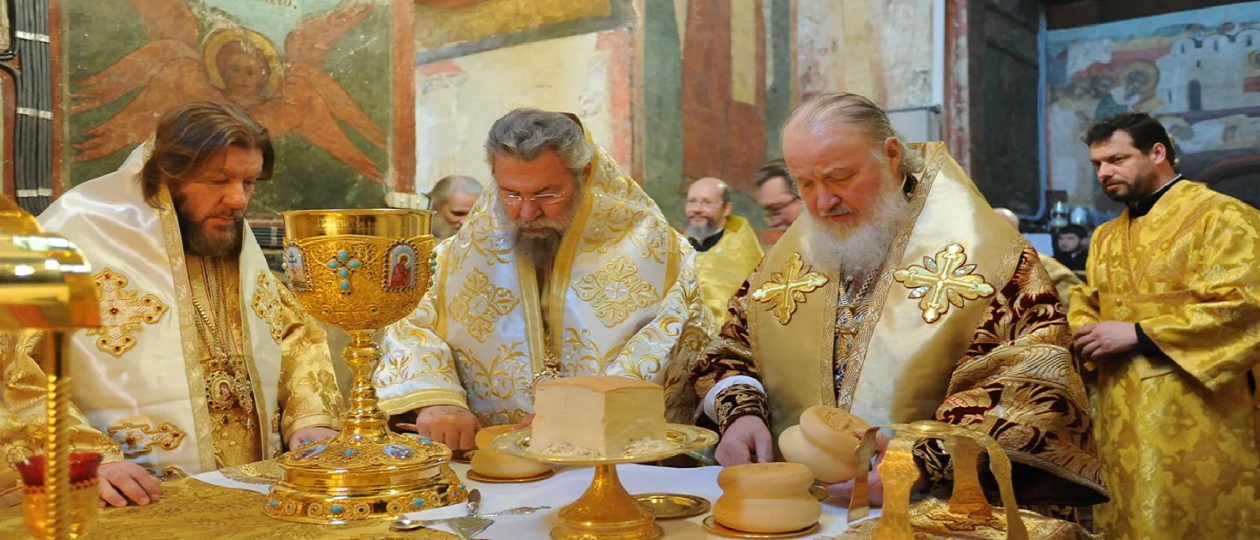
What is the purpose of the Divine Liturgy?
There are several important purposes to the Divine Liturgy. The Divine Liturgy of St. John Chrysostom is one of a number of different liturgical forms of the Holy Eucharist. In the Eastern Orthodox Church, the most common way of celebrating the Eucharist, is the Divine Liturgy of St. John Chrysostom. So the real question is “What is the purpose of the Eucharist?” There is not only one purpose, there are several. Some of the most important are: a) communion with Christ; b) manifesting the life of the Kingdom; c) thankful remembrance of the life and saving work of Jesus Christ; d) the forgiveness of sins; e) sharing in the sacrifice and resurrection of Christ; and f) the “koinonia” (fellowship) of the Christian community. Because of the importance of this question, nearly all of the rest of this column is devoted to answering it. I strongly recommend that you read it attentively.
All of the purposes mentioned above are inter-related and connect one with another. We separate them out only in order to discuss them. From the very beginning, the Eucharist was taught by Christ and the Apostles as a means by which Christians were able to come into actual and real communion with Christ. In this sacrament Christians receive the Body and Blood of Christ. For example, at the institution of the sacrament, Jesus said: “”Take, eat; this is my body.’ And He took a cup and when He had given thanks He gave it to them, saying, ‘Drink of it, all of you for this is my blood of the new covenant….”” (Matthew 26:26-27). In a totally mystical way, we receive the very body and the very blood of Christ in the Eucharist (read John 6 and 1 Corinthians 11:27-29).
The whole Eucharist service manifests the Kingdom of God wherever it is conducted. When God and His people, including both the clergy and the laity are gathered together in the Eucharist, there is a momentary realization on earth of the life of the eternal Kingdom. United together in one locality are the Father, the Son and the Holy Spirit, the people of God, the angelic hosts and all of the created and technically formed world (bread and wine). As we have seen above, the sacrament given by Christ, is “of the new covenant” which is the inauguration of the Kingdom of God. Then, at the Second Coming, it will be complete and total, now we have a foretaste of it. Matthew, Mark and Luke all recorded that Jesus referred to the Kingdom: at the institution of the sacrament. In the Eucharist we are most fully the Church, manifesting the life of God’s Kingdom on earth. That is why the Divine Liturgy is the central act of the Church.
In the Divine Liturgy we remember with gratitude and thanksgiving the saving and redeeming work and person of Jesus Christ. Jesus began the initial Eucharist by giving thanks” (Greek eucharistesas from which the name of the sacrament came). Jesus specifically said “Do this in remembrance of me” (1 Corinthians 11:24). The Liturgy is so constructed that much of its symbolism, in fact, reminds us of Jesus and His work of salvation.
Equally specific is Jesus’ statement that communion of His Body and Blood is for the forgiveness of sins” (Matthew 26:28). But St. Paul warns us that whoever, therefore, eats the bread or drinks the cup of the Lord in an unworthy manner will be guilty of profaning the body and blood of the Lord. Let a man examine himself, and so eat the bread and drink of the cup” (1 Corinthians 11:27 – 28). Forgiveness comes through the Eucharist to those who approach the chalice with reverence and a spirit of faith and repentance.
From the earliest times, the Eucharist has been understood as a sacrifice. Thus, St. Paul records Christ as saying: “For as often as you eat this bread and drink the cup, you proclaim the Lord’s death until He comes” (1 Corinthians 11:26). Many efforts have been made by theologians to understand the precise nature of the sacrifice in the Eucharist. Recent studies have shown that the early Fathers tended to understand our sharing in the sacrifice of the Eucharist in spiritual and moral terms, emphasizing humility and selfless acts of love for others.
The sacrificial aspect of the Eucharist also leads to an understanding of the communal and fellowship aspect of the life of the Church, its koinonia life. Just before the Great Eucharistic Prayer of the Divine Liturgy, the priest calls upon all the people saying “… let us make the Holy Offering in peace.” This is followed by the offering of the gifts of bread and wine: “The things that are Yours from the things that are Yours do we offer to You, according to all things and for all things.” We do this all together-clergy and laity – as a shared act of the Church. In the Eucharist we are united together in a communion of faith and sacrificial offering. And since we share the same cup together we are one, as a family of faith and God’s people, a true koinonia.
As you see, the purposes of the Divine Liturgy are many, and they all serve to help fulfill our major purpose in life which is to grow in the image and likeness and communion with God, becoming one with each other and with Him, that is, to achieve Theosis, which is eternal life.





